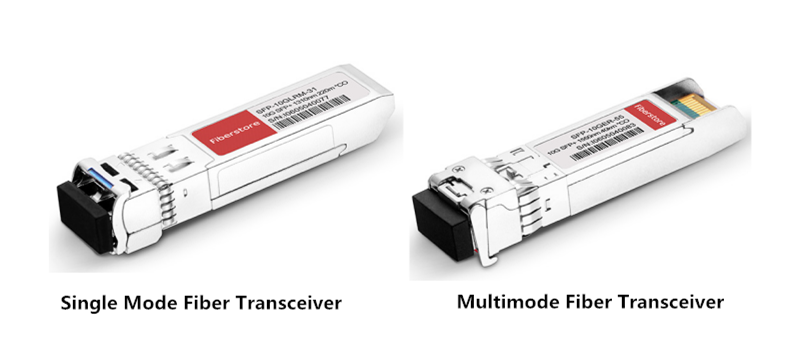Fiber optic transceiver is a commonly used device which can send or receive data in optical links. As the growing demand for higher speed and bandwidth, more high-speed optical transceivers like 40G QSFP+, 100G CFP and QSFP28 springs up in the market. And we cannot divide them according to data rate, but also the transmission mode—single mode transceiver and mulitmode transceiver. Then what’s the difference between them? Let’s uncover it.
It’s known to us that fiber optic cables can be classified into single mode and multimode according to its transmission mode. It’s same to fiber optic transceiver. Single mode fiber is a type of transceiver that allows one mode to propagate. It uses single mode fiber cable to receive and transmit data, which make it suitable for longer transmission. While multimode fiber optic transceiver support multiple mode transmission, and works with multimode fiber cable which has a larger core than single mode fiber cable. It’s transmission distance is less than that of single mode fiber transceiver because of dispersion.

Since there are so many types of optical transceivers in the market, choosing which types and cabling systems to install isn’t an easy thing. Therefore, knowing the differences between them is important. Here are the differences between single mode transceiver and multimode transceiver.
Laser sources: multimode optical transceiver often uses VCSEL which offers lower manufacturing package cost when compared with edge-emitting lasers. While single mode fiber has a core diameter of 9µm, which has less tolerance to fiber core misalignment as compared to multimode fiber. Therefore, it has higher requirement and cost for lasers.
Power consumption: multimode transceivers consume less power than a single mode transceivers, which is an important consideration especially when assessing the cost of powering and cooling a data center.
Distance: the reach distance of the two types transceiver is different. The multimode optical transceivers generally have a reach of approximately 550 meters, while the single mode transceivers can get you through 10 km, 40 km, 80 km and even farther.
Speed: in telecom applications where the fiber cost is high due to long-distance data transmission, single mode transceivers can support higher speed rates with fast response time, advanced modulation formats and wavelength division multiplexing (WDM) technology.
Cost: in terms of cost, single mode transceiver are nearly two or three times higher in price when compared to multimode transceiver. Because single mode fiber cables cost more to make and are more “fragile” in nature, which makes them more expensive than multimode fiber cables.
This post gives a simple comparison between single mode transceiver and multimode transceiver. Both of them have their own advantages in data center applications. Whether you choose the single mode or multimode transceiver, it’s important to note that different optical transceivers aren’t interchangeable due to the differences in fiber core size and wavelengths. FS.COM, as a professional optical products supplier, offers various fiber optic transceiver to meet customers’ diverse needs. If you have any need, please visit www.fs.com for more detailed information.
